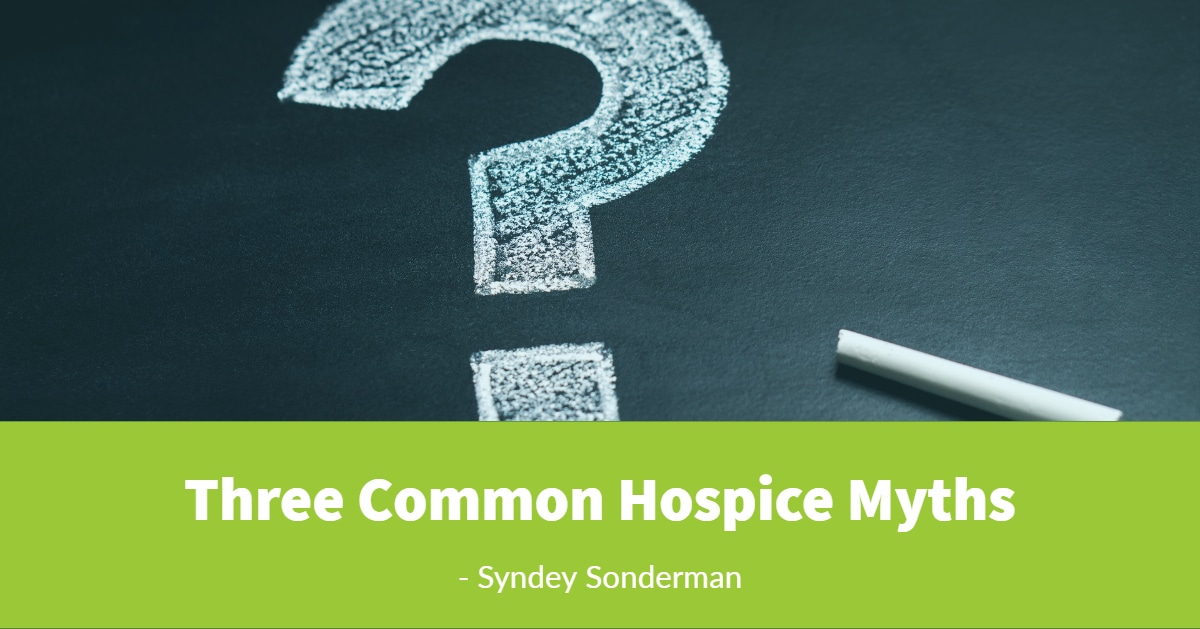Three Common Hospice Myths
By Syndey Sonderman
Hospice is a branch of healthcare that seems to be widely stereotyped, minimally understood, and fearfully avoided. Receiving a medical suggestion including the word “hospice” may trigger immediate panic, hopelessness, anger, or disbelief. It may seem far-fetched to imagine that receiving hospice care could increase hope and create moments of beauty. Let’s dispel some scary myths about hospice and find out if this can be a valuable thing.
Common Myth 1: Hospice is where people go to die
First things first, hospice is not a place. Hospice is an approach to healthcare that can be provided in many different settings. Hospice is a service that visits someone wherever they call home. Hospice services can be utilized at home, a friend/family member’s home, in a care community, a hospice bed in a hospital, or at a residential hospice location.
Most importantly, hospice is actually less about dying and more about living. When the focus of care is shifted from curing, through any aggressive and invasive means possible, to easing pain and discomfort, it seems a little more believable that positive events can happen. When a loved one starts receiving care from a hospice team, the goal shifts entirely to answer the question of “How does this person want to live during the time they have left?” Hospice teams consider what matters most to someone, and try to give as much attention to those matters as possible.
“If fears need to be acknowledged or tears released, a social worker will sit in silence or explore and honor these feelings aloud.”
Myth 2: Hospice means there is nothing more to be done, that no more care can be given
When hospice care begins, the priority of care is entirely directed towards comfort, comfort, and more comfort. The term comfort embraces physical, emotional, spiritual, and personal support. If pain exists, medicine can be given to ease the hurt. If muscles are sore or skin is dry, an aide or nurse will give a massage or soothe tender skin with lotion. If a family is having a hard time understanding what is happening, a nurse can provide gentle education to help them make sense of their worries. If fears need to be acknowledged or tears released, a social worker will sit in silence or explore and honor these feelings aloud. If faith is shaky or doubts arise, a spiritual care member can validate, explore, and join in prayer. Hospice care means love and attention to the whole person – mind, body, and soul.
“.. this style of care opens space for family members to be present with their loved one.”
Myth 3: Hospice means everyone has given up and will abandon you or your loved one
Hospice care consists of an entire team of people who work together to attend to those they serve. A hospice team consists of a physician, nurse, aide, social worker, and chaplain. Volunteer companions and a bereavement counselor may also be part of a hospice care team, should an individual or family benefit from this kind of support. Not only is a new quality of care provided with hospice services, but this style of care opens space for family members to be present with their loved one. With a care team managing symptoms and providing weekly hygienic tasks, families can often return to their familiar role as spouse, mother, father, son, daughter, grandchild, relative, or friend.
Now that we’ve confronted some common myths surrounding hospice care, the idea hopefully sounds a little less daunting. As much as we all try, we cannot ignore the reality that we will encounter death. This life is as much about dying as it is about living – we live until the moment we die. Hospice workers and volunteers choose to honor dignity, choice, and interpersonal connection during all interactions with those they serve. The goal of hospice care is to preserve those rights as a human being through the final moments of every precious life.
Sold Out hospice stories on our hospice blog
Please feel free to contact us with any questions regarding hospice care


